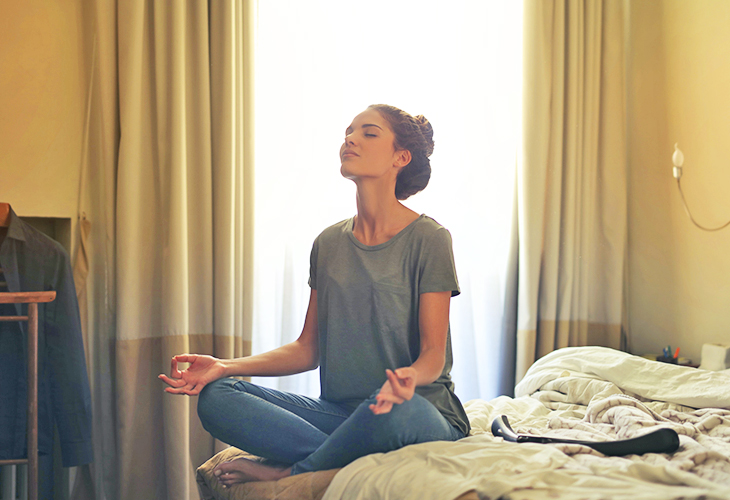Did You Know You Need 7 Types of Rest? See Which Types You Need Here

Have you ever had eight hours of deep sleep, only to wake up still feeling exhausted? Or felt more rejuvenated after volunteering than after taking a nap, even at your most fatigued?
We often consider sleep and rest to be the same thing, but they are very different and, in fact, there are actually seven types of rest.
We often confuse sleep and rest, thinking we’ve effectively rested because we’ve gotten enough sleep. Waking up still feeling depleted mainly happens because we neglect to replenish the other types of rest we desperately need.
The outcome: A culture of high-producing, top-performing, chronically tired people who suffer from a rest deficit because they do not understand that real rest is powerful.
In an interview with The Shine App, physician Dr. Saundra Dalton-Smith, M.D. stated, “Most people, when they think about rest, have a very one-sided approach—they lounge around, don’t do anything, and think that’s what rest is… We try it, and when we’re still rest-deprived, we think it doesn’t work.”
“People say, ‘I’m tired all the time. I’m drained.’ If they’re waking up (after sleeping) and still exhausted, the issue probably isn’t sleep. It’s likely a rest deficit,” Dr. Dalton-Smith explains about her patients.
Recharging yourself by getting proper rest requires recognizing the exact rest you need.
According to Dalton-Smith, who is also the author of Sacred Rest: Recover Your Life, Renew Your Energy, Renew Your Sanity and founder of Restorasis, a professional development agency dedicated to restoring well-being in the workplace, there are seven types of rest humans need.
Sleep alone is not enough. If you are ready to truly restore yourself, where you feel truly rested, read on to learn about the seven different types of rest and how to refuel yourself.
The 7 Different Types of Rest and How to Replenish Them When They’re Depleted:
Recharging yourself by getting proper rest requires recognizing the exact rest you need.
Rest should equal restoration, and there are seven different types of rest that must be restored when depleted: physical rest, mental rest, emotional rest, social rest, spiritual rest, creative rest and sensory rest.
Real rest is powerful.
Each type of rest has its own characteristics that will reveal themselves if a deficit occurs. The cure to feeling run-down and burned out isn’t always simply going on vacation, nor is it necessary to take a sabbatical. It is identifying and understanding the particular types of rest you need the most and then incorporating small daily routines to replenish them.
Here are the seven different types of rest plus tactics tailored to specific deficits so you can know how to restore them.
1. Physical Rest

The first type of rest we need to restore is physical rest. The most common form of physical rest is sleep, and we require high-quality sleep to feel recharged.
But there’s a passive and active approach to taking physical rest. Passive physical rest consists of napping and sleeping. Active physical rest can include restorative exercises that improve your body’s circulation and flexibility, such as yoga, stretching and massage therapy.
Physical rest is the act of relieving the body of physical stresses. If you find yourself less energized and more tired, struggling to keep your eyes open and straining to get out of bed, chances are you are physically exhausted.
We often consider sleep and rest to be the same thing, but they are very different.
Signs that you may be experiencing a physical rest deficit include aches and pains in the body, swelling in the legs and feet, and spasms along the back.
To receive the physical rest you need, try taking deep breaths during the workday and ensuring that your work environment’s ergonomics are non-toxic to your body. Let your body recover by skipping that HIIT class or stretch it out by squeezing in a restorative yoga class. You can also always hit the hay a little earlier in the evening.
2. Mental Rest
The second type of rest we need to replenish is mental rest to refocus and silence our “busy brains.” Lacking mental rest causes difficulty concentrating and recalling information.
Someone who experiences mental unrest will often place their head on their pillow to sleep but instead find their mind racing keeping them from falling asleep. Even after seven to nine hours of sleeping, frequent irritability and forgetfulness can occur as if they never slept.
Reading the same sentence on a page several times or sending a barely-comprehensible email are some tell-tell signs that you need mental rest. Thoughts turning negative, becoming judgmental, and feeling like your mind has mutated to mush are other signals that you need to take a mental break.
When needing the mental type of rest, make time to ground yourself with meditation and repeating a calming mantra. Rest your mind throughout your workday by scheduling short breaks. Shut down your screens and keep a notepad nearby to jot down any nagging thoughts that keep your mind racing when it should be resting.
8 Ways to Boost Your Mental Health Today (And Keep It That Way)
3. Emotional Rest

Shutting your brain off can provide rest in certain situations, but it’s just one of the seven forms of rest that help us to function as humans. Another type of rest we need to recharge is emotional rest, so we can fully express genuine feelings and nix those annoying people-pleasing tendencies.
Many of us carry our emotional labor privately, in that we don’t share what we are truly feeling. Not wanting to share financial troubles with your family or being the manager who has to lay off most of their team are examples of emotional labor. Many hide their feelings without allowing them to be exposed, expressed and healed.
Moments when someone is feeling everything at once—angry, confused, exhausted AND hungry, for example—is someone who requires emotional rest. Emotional rest refers to the rest we experience when we dare to be genuine and authentic in freely sharing our feelings.
An emotionally rested person can have the hard, honest conversation that otherwise would go unsaid. The opposite feelings one would experience when they do not receive emotional rest are constantly having to check their emotions, and lack the freedom to be truthful about their feelings.
To experience more emotional rest, offload your feelings to a willing listener, then keep the communication open to prevent future emotional overload. Schedule regular therapy sessions or find others with whom you can be 100% yourself.
13 Ways to Tell If You Are Emotionally Healthy (And How to Get There If You Answered No)
4. Social Rest
If you need emotional rest to recharge, you may need some social rest too. Social resting recognizes which relationships are rejuvenating and which ones are not. A social rest deficit occurs when we fail to differentiate between those relationships that revive us from those that wear us out.
Being in social settings can take a lot out of someone, especially since most of us may spend most of our time with people who are draining our energy. A sign you need social rest is when you feel everybody’s taking and not giving back to you in return.
Social rest is the rest we experience when we’re around life-giving people.
For the social type of rest, surround yourself with others who are positive and supportive. Catch up with an old friend who knows you well. Or, when interacting with others virtually, engage more fully by turning your camera on and focusing solely on the person you are speaking to.
You can also take a night off from socializing to reconnect with yourself. Evaluate the relationships you currently have in your life. Consider the people you spend time with just enjoying each other’s company and being in each other’s presence. Counteracting draining encounters with restorative ones can help bring balance and social rest.
5 Ways to Create Balance Between Your Work and Personal Life
5. Spiritual Rest

If you’re feeling afloat, unanchored, afraid or alone, you may need to recharge with some spiritual rest. The spiritual typer of rest is seen as tuning into your spiritual beliefs and tapping into your higher power. But the root of spiritual rest is the need for belonging, the feeling that our work and efforts are for the greater good.
Spiritual rest needs vary based on someone’s belief system, but we all wish to feel that who we are and what we contribute to the world matter.
Someone suffering from not receiving spiritual rest is someone who feels their abilities don’t benefit anybody. But having spiritual rest means connecting beyond the physical and mental for a more profound sense of belonging, love, acceptance and purpose.
If you’re seeking spiritual rest and a sense of purpose, practice your religion and consider adding prayer, or connect with your higher self through meditation.
Find a way to cultivate a connection through your community or culture (work or faith-based). Engage in something greater than yourself by volunteering however you feel called to be of service.
6. Creative Rest
Creative rest is the type of rest we experience when we appreciate beauty in any form and allow it to inspire and excite us. Whether it’s natural beauty: like the oceans, the mountains, the trees, the waterfalls, or created beauty: such as art, music and dance, creative rest awakens the awe and wonder inside each of us.
We are all creatives, whether we realize it or not. If you brainstormed solutions at work, played with your children, built a piece of furniture or planned a party, chances are you’ve had to tap into your creativity.
But when a lot of creative thinking is required, especially by those who don’t see themselves as creative, replenishing their drained creative energy is less likely to be considered.
It’s imperative for those who must solve problems and think up new ideas to have creative rest.
Signs someone can tell they have a creative rest deficit is when they have a hard time being innovative and problem-solving is challenging.
Fill your creative cup by surrounding yourself with things that interest and inspire you. Go for a walk outdoors at a local park, around your neighborhood or in your backyard. Transform your area into a space for inspiration. Display pictures of people, images of places, or sayings that spark your passion for creativity and ignite innovative ideas.
Activities that remove the pressure of creating, like getting lost in a good old-fashioned book, are a great way to bring creative rest.
Feeling Uninspired? Here’s How to Use Meditation to Boost Your Creativity
7. Sensory Rest

The seventh type of rest that needs replenishing is the most prevalent drainer giving credit to the prevalence of screens, according to Dalton-Smith. In her practice, Dalton-Smith shares with The Shine App that with sensory exhaustion, it’s becoming easier to talk to the computer… breaking intimacy and, over time, breaking relationships.
All of these sensory inputs in time can cause sensory overload syndrome. The number one way most of us respond to sensory overload is with agitation, irritation or frustration. So people with a sensory rest deficit feel fine at the beginning of the day, but find themselves agitated, irritable or frustrated by the end of it.
Catch up on sensory rest by setting aside the digital devices and stepping outside for fresh air.
The sensory input that surrounds us that we are constantly and possibly subconsciously responding to might be the bright lights in our rooms, screens in our faces, and multiple conversations that can cause our senses to feel overwhelmed.
To replenish depleted sensory rest is to diminish sensory input received from aromas, devices and background noises. Dalton-Smith also states that our national form of rest is canceling plans and turning on the television resulting in more exhaustion than before.
Beginning with intentional moments of sensory deprivation, the damage inflicted by the over-stimulating world can be undone. This sensory overwhelm can be countered by mindfully closing your eyes for a few minutes in the middle of the day and intentionally unplugging from electronics at the end of every day.
Check-in with yourself before reaching for the remote to see if staring at a screen is really the rest you need right now.
Too Much Screen Time? Go Unplugged With a Digital Cleanse – Here’s How In 6 Simple Steps
Replenish All 7 Types of Rest to Feel Recharged
When Dr. Saundra Dalton-Smith started her journey, she had built a very successful-looking life on the outside. However, inside, she was tired, drained, burned out and needed all seven types of rest. She started with emotional rest, the type of rest she needed the most.
As a physician, Dalton-Smith was working in the ER and the ICUs dealing with life and death all day almost on a daily basis. Then she would go home and try to smile and be happy for her family with no one she could talk to.
She was carrying excessive emotional labor and had an emotional rest deficit. Needing to understand this about herself so that she could heal from it and arrive at a better place was the starting point for her.
Dalton-Smith says, “For a lot of people, if you have a deficit in an area, you’re likely to experience specific symptoms.”
If your deficit is in mental rest, you might have trouble concentrating. If your deficit is in emotional rest, you might argue with your partner over anything. And if your deficit is in sensory rest, loud sounds might have you on pins and needles, making you chronically anxious.
Sleep alone cannot fully restore us to the point where we feel truly rested.
Dalton-Smith recommends starting at the area with the biggest deficit by taking her rest quiz to help you figure out where to begin and identify your highest level of rest deficit. Pick a type or two to start implementing some restoration strategies for resting.
As you can see, sleep alone cannot fully restore us to the point where we feel truly rested, when there are many types of rest we need to account for.
So it’s time for us to focus on getting the real rest we need. Fill your empty cup with a restoration process that you can practice at any time with minimal restrictions. Create a system of small routines to start feeling recharged by honoring each type of rest that you need.
Which type of rest do you need to feel recharged right now? Comment below. We love hearing from you!


This Month's Letter
From the Editor
Monthly motivation and food for
thought from our founder.





























